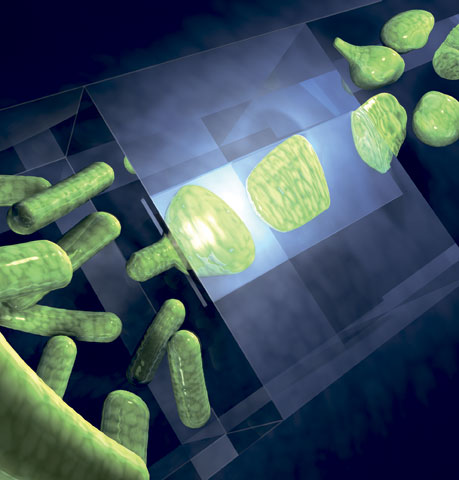Bacteria can creep through crevices that are half their size. Researchers from the Kavli Institute of Nanoscience showed how bacteria perform this astonishing trick.
Bacteria are accustomed to living in cramped quarters. Their natural growth and movement in confined spaces play an important role in soil microbiology, water purification and microbial infections. Micro pores smaller than 0,2 micron (a thousandth millimeter) are generally assumed to be small enough to keep bacteria out, but the Kavli researchers, biophycist prof.dr. Cees Dekker and evolutionary biologist dr. Juan Keymer, have recently found that numerous bacteria can indeed pass through these membranes and live happily ever after. These findings not only have implications for water purification installations, but also for medical or dental implants that now need to be sealed off even better than was previously assumed.
Dekker and his colleagues at the Kavli Institute for Nanoscience (faculty of Applied Sciences) experimentally determined how different bacteria (escherichia coli and ba-cillus subtilus) propagate through extremely narrow micro channels. Their findings were recently publi-shed in Proceedings of the National Academy of Sciences (PNAS, August 17th 2009).
Their set-up consisted of a number of square wells etched into a silicium substrate, which were connected by 50-micron long micro channels with widths measuring down to 0,3 micrometer. Bacteria, brought in from one side, were lured to the other side, where a solution with nutrients circulated. The bacteria were genetically modified to fluoresce, which enabled observation by an optical microscope.
The e.coli bacteria are rod-shaped, with a diameter of about 0.9 micrometer. They swim about by sweeping tiny hairs (flagella) at their surface, and they can do so in channels with diameters down to about 1,1 microns, so the researchers discovered. A 50-micron channel will then be crossed in just a couple of seconds. In even narrower passages, the swimming can no longer be observed.
But that doesn’t mean the bacteria can’t pass through. Time-lapse photography from bacteria in a 0,6 micron channel for example show that, even though bacteria cannot move through the channel (remember, it’s smaller than their body diameter), instead they propagate by dividing. Ten hours after bacteria have entered at one end of the submicron channel, a bacterium ten to fifteen generations younger emerges on the other side. It was found that e.coli bacteria can thus ‘tunnel’ through channels as narrow as 0,4 micron. “Even for an observation of a week, we have not seen bacteria enter and grow in 0.3 micrometer wide vertical channels,” the researchers report. So, how bacteria have managed to creep through 0,2-micrometer pores, as reported by other researchers, remains something of a mystery.
The bacterial limbo does seem to come at a cost for the bacteria involved. The Kavli researchers have noticed that E.coli bacteria, which are normally cigar-shaped, deform in order to ‘creep’ through the submicron channels. Bacteria become flattened and look like hip flasks. Bacteria that emerge from the far side of the channel appear wrinkled and have lost the ability to swim. But hold on, although they might look strange and passive, they have not lost the ability to divide. And one to two days later, their ‘offspring’ have returned to the normal cigar-shape and have also regained the ability to swim.
Dekker is fascinated by this bacterial transformation into a form (‘morphological phenotype’) that was unknown until now. By making a series of wells connected by submicron channels, the researchers have shown that bacteria can even undergo a series of these transformations.
It must be said though that not all bacteria are equally limber. B. subtilis bacteria for example have, unlike E. coli, not been seen to enter channels narrower than their body width. Nonetheless the authors conclude that submicron-sized pores and cavities may harbour much more bacteria than previously assumed. Let’s hope implant designers will take notice.
“Dat zou ook heel nuttig zijn voor Nederlandse studenten”, zegt professor Gerard Kerkhof. Hij is slaapdeskundige aan de Universiteit van Amsterdam. Hij pleit al jaren voor lessen in slaap.
“Let op je slaaphygiëne”, adviseert hij. “Door slordig slaapgedrag vermindert de concentratie, wordt het geheugen zwakker en verminderen de prestaties. Het is een impopulaire boodschap, maar je moet niet verwachten dat je op maandagochtend fris en helder bent, als je in het weekend laat naar bed gaat. In het weekend bezorgen veel mensen zichzelf een soort jetlag waar ze twee dagen van moeten herstellen.”
Volgens hem hangen de hormoonspiegel, het immuunsysteem, de lichaamstemperatuur en het slaapritme met elkaar samen. Als de samenhang verbroken wordt – bijvoorbeeld door slaaptekort – dan kun je dat merken. “Eén op de tien Nederlanders heeft last van slapeloosheid. Het is een miskend probleem, waar mensen te luchtig over doen.”
Lees hier meer over de slaaples in Texas.



Comments are closed.